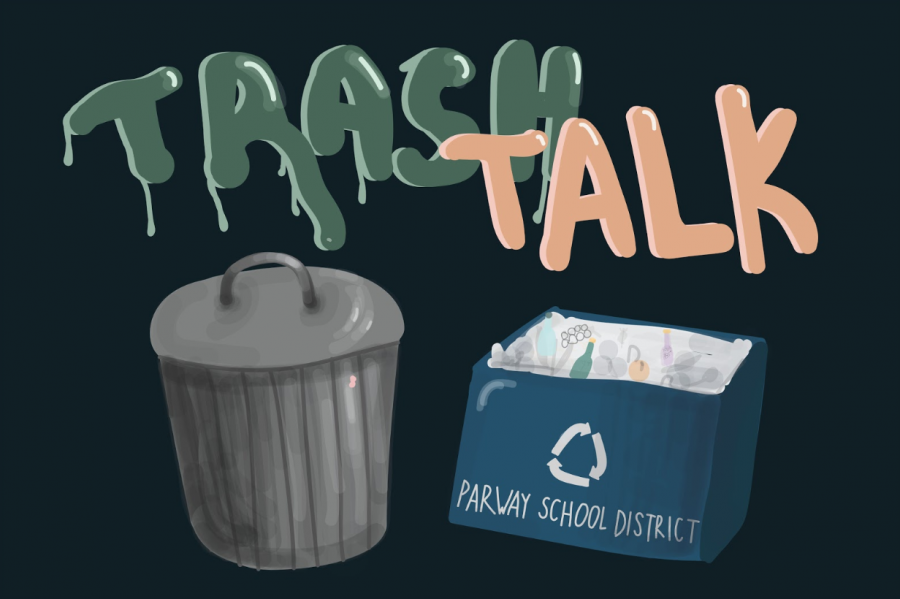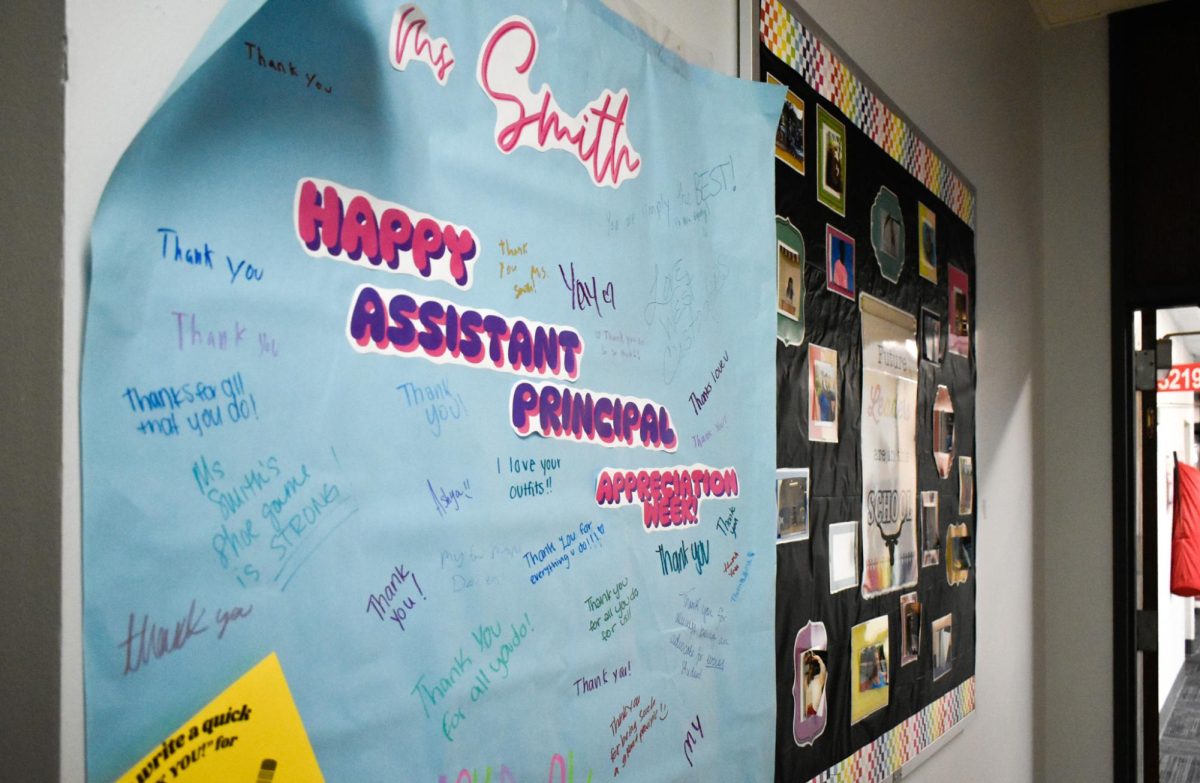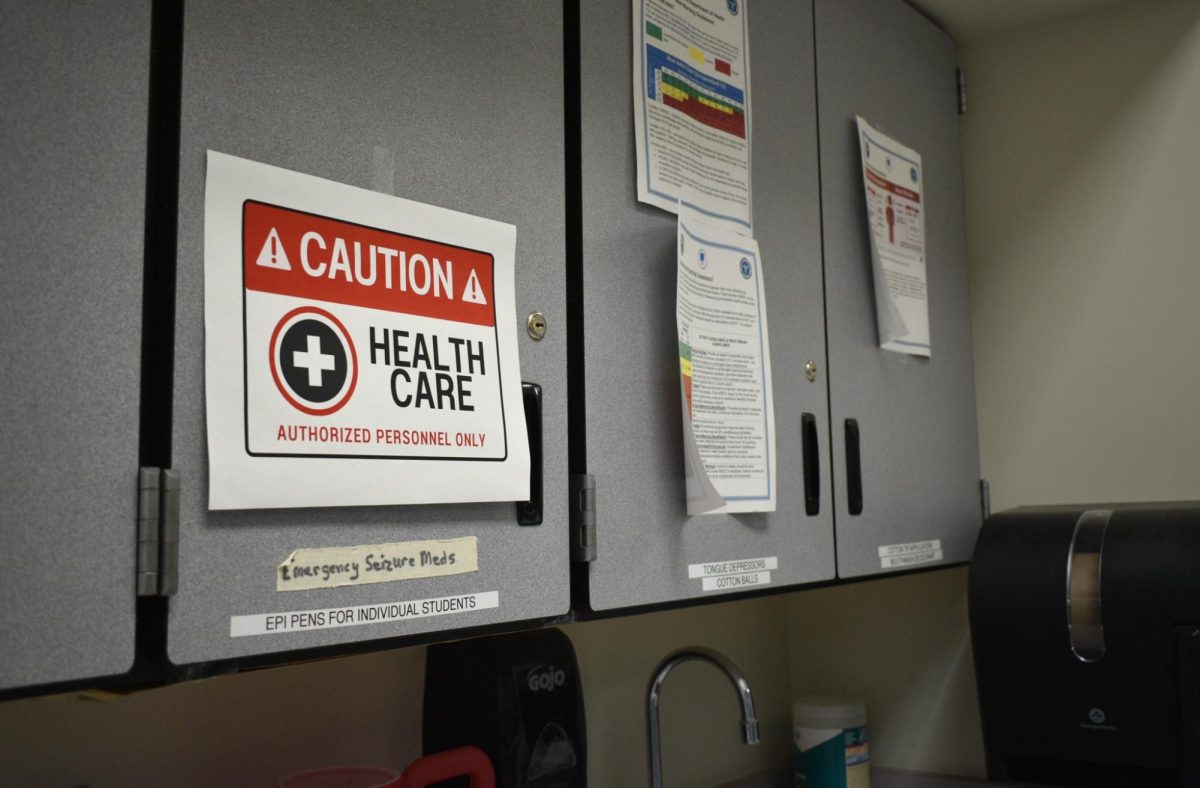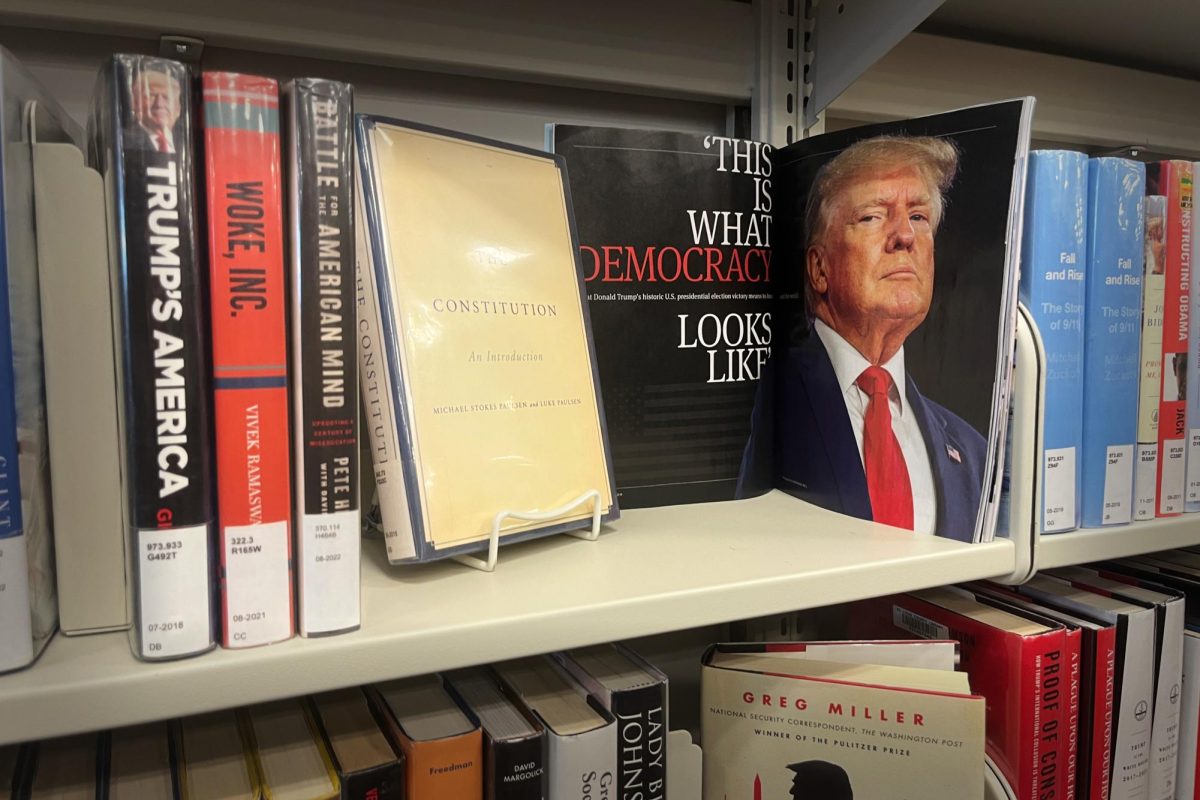The cafeteria during sixth hour, now absent of laughter and warmth, is completely still at first glance. A second look reveals custodian Sean Smith continuing his daily agenda of shuffling through bins–blue, yellow and gray–making a thorough effort to separate the bits of trash which have been so carelessly tossed in the recycling bins. If trash is found in the recycling, the school will be fined, sometimes leaving custodians with no choice other than to throw the recycling-trash mixture out as trash.
We, as students, neglect the importance, tedious care and dedication that goes into keeping our school sanitary and polished day after day.
“My day starts out with unlocking the building. Then, it goes to clean up the restrooms so everybody can have one,” custodian Sean Smith said. “It’s not a fresh start. You go ahead and you get ready to set up what needs to be set up. But what happens when you start getting coffee spills? What happens if somebody left a spill that nobody cleaned up the night before? Or, somebody might need help delivering something right way. Everyday is not the same, but I’m by myself until 10:30. That’s when the mid-shift guy gets here. So every call you’ve got from six in the morning to 10:30 is me.”
Students’ careless waste management coupled with the understaffing of custodians and increased building renting to result in a minor environmental disaster: cafeteria recycling being taken out with the trash.
“Technically, we don’t have to [sort through trash],” Smith said. “But it’s because they’re not following the example of what we would like. The yellow trash bins are for anything that contains food. The blue trash cans are for your recycling. The grey trash cans are for trash. I feel as though if you take the time to explain that on the first day of school of orientations, when everybody comes and talks to them, explain to them exactly how this goes. You might have to follow up maybe a whole week, during lunches, just so they can get [into] the habit of it. Other than that, that’s how we do it. We sort it so [that] one, it helps the trash from overflowing. Two, it helps with the mulch and compost. It’s always a team effort, so technically we don’t have to dig through the trash, but we do.”
Outside groups renting out our building after school and over the weekends is one cause of the issue. As the number of outside groups renting the building after hours increases the custodial responsibility of setting up for these organization is utilized more and more often. Having to place 300 chairs in neat, orderly rows or breaking down 40 cafeteria tables takes valuable time out of the custodians’ already overloaded work schedules.
“If you’re not prone to working hard like I am, then when they are short staffed you’re just gonna wanna go home, but see I’m here after work,” Smith said. “Most of the time I’m overtime. One time I did 32 hours overtime. They take it out of tax, made me cry. But they needed me. Over the weekend for the craft fair I did 22 hours overtime for Saturday and Sunday because they needed me.”
For the past few years, national unemployment rates have been relatively low; building manager Kitty Strong believes that this may contribute to why the custodial staff, bus drivers and cafeteria workers are understaffed. Currently, there are only eleven employed custodians out of the twelve necessary to keep the building functional.
“One custodian last year was let go, probably around this time, and she has never been replaced; every night we are short one custodian, which means the other custodians have to pick up the slack for that custodian. So the area that that custodian would clean is being cleaned by all the other custodians, each of them getting a part of that,” Strong said. “On top of doing their job or their area that they do, they’re having to do part of someone else’s area––and that doesn’t include setting up the gym for sports, setting up the library for meetings at night, things like that. If there’s an event in the cafeteria that might have food, they have to go back there again and clean up the cafeteria.”
While unemployment advances the problem, the issue would be impacted mostly if students were simply more conscious about how their actions impact others and their environment.
“It’s hard, and I can see sometimes Sean will be picking out certain trash out of say, recycling, and putting it into the compost. No one is putting [their waste] in the right containers, and we do have new signs and posters. I just hung them up myself in the cafeteria and in the breezeway, so it’s hard when you can’t still get everyone on the same page: to recycle,” Strong said. “[The custodians] are actually picking through the trash and moving some of it over, so I think it has to be whole community effort, and if everybody’s not on board, it only makes it harder.”
While other factors such as underemployment and increased building use do have an effect, the root of the problem is negligence towards the importance of disposing of waste correctly on the daily, and it will take a community effort to fix it.



![Leaning on the podium, superintendent Melissa Schneider speaks to Parkway journalism students during a press conference. Schneider joined Parkway in July after working in the Thompson School District in Colorado. “My plan [to bond with students] is to get things on my calendar as much as possible. For example, being in [classes] is very special to me. I am trying to be opportunistic [meeting] kids [and] being in [the school] buildings. I have all the sports schedules and the fine arts schedules on my calendar, so that when I'm available, I can get to them,” Schneider said.](https://pwestpathfinder.com/wp-content/uploads/2025/09/IMG_5425-1200x943.jpeg)


![Red, white and blue, the American flag holds the values of our democracy. The fight that we once endured has returned, as student journalists and senior correspondents across the country are losing their voices due to government control. “[Are] the White House and [the] government limiting free speech [and] freedom of the press? Yes [they are],” chief communications officer of the Parkway School District and former journalist Elisa Tomich said.](https://pwestpathfinder.com/wp-content/uploads/2025/03/Untitled-design-14.jpg)
![A board in the Parkway West counseling department displays pennants of selective universities. With a wide range of students interested in attending, it’s important that these schools have clear priorities when deciding who to admit. “[Washington University] had the major that I wanted, psychology, philosophy, neuroscience. That's a holistic study of the brain, and [WashU is] the only college in the world that offers that. That's the main reason I wanted to go; I got into that program,” senior Dima Layth said.](https://pwestpathfinder.com/wp-content/uploads/2025/02/Flag-1.png)

![Within the U.S., the busiest shopping period of the year is Cyber Week, the time from Thanksgiving through Black Friday and Cyber Monday. This year, shoppers spent $13.3 billion on Cyber Monday, which is a 7.3% year-over-year increase from 2023. “When I was younger, I would always be out with my mom getting Christmas gifts or just shopping in general. Now, as she has gotten older, I've noticed [that almost] every day, I'll open the front door and there's three packages that my mom has ordered. Part of that is she just doesn't always have the time to go to a store for 30 minutes to an hour, but the other part is when she gets bored, she has easy access to [shopping],” junior Grace Garetson said.](https://pwestpathfinder.com/wp-content/uploads/2024/12/DSC_0249.JPG-1200x801.jpg)

![Senior Sally Peters stands in the history hallway, contemplating her choices in the 2024 United States and Missouri elections on Nov. 5. As a member of Diplomacy Club, Peters has discussed key candidates and issues in contemporary American politics. “[As students], we're starting to become adults. We're realizing how much the policies that are enforced and the laws that make it through the House and Senate are starting to affect us. [Opportunities such as] AP [U.S.Government] and Diplomacy Club [make elections feel] a lot more real,” Diplomacy Club vice president and senior Nidhisha Pejathaya said.](https://pwestpathfinder.com/wp-content/uploads/2024/10/Flag-1-1.png)
![Mounting school pressure can leave many students overworked and overstressed. Schools must give students the necessary resources to help assuage student mental health issues and prevent the development of serious crises. “The biggest thing [schools] can do [to protect student mental health] is offer more time [to do work], like a study hall, or offer more support from teachers so that students don't feel stressed out and can get help in areas that they need,” senior Bhavya Gupta said.](https://pwestpathfinder.com/wp-content/uploads/2024/09/unnamed-4.jpg)
![After a thrilling point, senior Katie Byergo and junior Elle Lanferseick high-five each other on Oct. 8. With teamwork and camaraderie, Byergo worked together in the game against Lafayette High School. “[Byergo’s] is really positive with a good spirit,” Lanferseick said. “I set her [the ball] and she hits it [or] gets the kill.”](https://pwestpathfinder.com/wp-content/uploads/2025/10/DSC_9349-1-e1761159125735-1200x791.jpg)
![Focused on providing exceptional service, sophomore Darsh Mahapatra carefully cleans the door of a customer’s car. Mahapatra has always believed his customers deserve nothing less than the best. “[If] they’re trusting us with their car and our service, then I am convinced that they deserve our 100 percent effort and beyond,” Mahapatra said.](https://pwestpathfinder.com/wp-content/uploads/2025/10/DSC_0018-1200x800.jpg)
![Sophomore Aleix Pi de Cabanyes Navarro (left) finishes up a soccer game while junior Ava Muench (right) warms up for cross country practice. The two came to Parkway West High School as exchange students for the 2025-2026 school year. “The goal for the [exchange] program is to provide opportunities for both Parkway students and our international exchange students to learn about other cultures, build connections and become confident, capable, curious and caring — Parkway’s Four C’s — in the process,” Exchange Program Lead Lauren Farrelly said.](https://pwestpathfinder.com/wp-content/uploads/2025/10/Feature-Photo-1200x800.png)
![Gazing across the stage, sophomore Alexis Monteleone performs in the school theater. The Monteleone family’s band “Monte and the Machine” has been releasing music since 2012, but Alexis started her own solo career in 2024 with the release of her first single, Crying Skies. “My whole family is very musical, [and I especially] love writing [songs with them],” Monteleone said.](https://pwestpathfinder.com/wp-content/uploads/2025/09/DSC7463-1200x798.jpg)

![Leaping through the air, senior Tyler Watts celebrates his first goal of the season, which put the Longhorns up 1-0 against the Lafayette Lancers. Watts decided to play soccer for West for his last year of high school and secured a spot on the varsity roster. “[Playing soccer for West] is something I had always dreamed of, but hadn’t really had a good opportunity to do until now. It’s [really] fun being out [on the field], and I’m glad I decided to join the team. It’s just all about having fun with the boys and enjoying what time we have left together,” Watts said.](https://pwestpathfinder.com/wp-content/uploads/2025/09/DSC_1951-1200x855.jpg)
![Shifting global trade, President Donald Trump’s tariffs are raising concerns about economic stability for the U.S. and other countries alike. “[The tariffs are] going to pose a distinct challenge to the U.S. economy and a challenge to the global economy on the whole because it's going to greatly upset who trades with who and where resources and products are going to come from,” social studies teacher Melvin Trotier said.](https://pwestpathfinder.com/wp-content/uploads/2025/05/MDB_3456-1200x800.jpg)

![Pitching the ball on Apr. 14, senior Henry Wild and his team play against Belleville East. Wild was named scholar athlete of the year by St. Louis Post-Dispatch after maintaining a high cumulative GPA and staying involved with athletics for all of high school. “It’s an amazing honor. I feel very blessed to have the opportunity to represent my school [and] what [it] stands for,” Wild said.](https://pwestpathfinder.com/wp-content/uploads/2025/05/unnamed-6-1200x714.jpg)
![Freezing in their position, the Addams Family cast hits the “rigor mortis” pose after cast member and senior Jack Mullen, in character as Gomez Addams, calls out the stiff death move. For the past four months, the combined company of cast members, orchestra pit, crew and directors all worked to create the familial chemistry of the show. “I’m excited for [the audience] to see the numbers, the music, the scenes, but I also just love all the technical aspects of it. The whole spectacle, the costumes, makeup and the people that put in the work backstage in order to make the show successful on stage. I’m excited for people to see and appreciate that,” Mullen said.](https://pwestpathfinder.com/wp-content/uploads/2025/03/DSC0116-1200x800.jpg)
